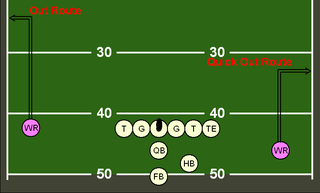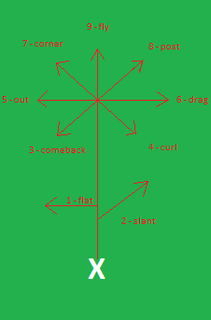
A running back (RB) is a member of the offensive backfield in gridiron football. The primary roles of a running back are to receive handoffs from the quarterback to rush the ball, and block. There are usually one or two running backs on the field for a given play, depending on the offensive formation. A running back may be a halfback, a wingback or a fullback. A running back will sometimes be called a "feature back" if he is the team's starting running back.

A cornerback (CB) is a member of the defensive backfield or secondary in gridiron football. Cornerbacks cover receivers most of the time, but also blitz and defend against such offensive running plays as sweeps and reverses. They create turnovers through hard tackles, interceptions, and deflecting forward passes.
In gridiron football, blitzing is a tactic used by the defense to disrupt pass attempts by the offense. During a blitz, a higher than usual number of defensive players will rush the opposing quarterback, to try to tackle the quarterback or force him to hurry his pass attempt.
Strategy forms a major part of American football. Both teams plan many aspects of their plays (offense) and response to plays (defense), such as what formations they take, who they put on the field, and the roles and instructions each player are given. Throughout a game, each team adapts to the other's apparent strengths and weaknesses, trying various approaches to outmaneuver or overpower their opponent in order to win the game.
The hook and lateral is a trick play in American, Canadian football & indoor American football, often colloquially called the hook and ladder play.

Single set back is an offensive base formation in American Football which requires only one running back lined up about five yards behind the quarterback. There are many variations on single back formations including two tight ends and two wide receivers, one tight end/three wide receivers, etc. The running back can line up directly behind the quarterback or offset either the weak side or the strong side.
A trick play, also known as a gadget play, gimmick play or trickeration, is a play in gridiron football that uses deception and unorthodox tactics to fool the opposing team. A trick play is often risky, offering the potential for a large gain or a touchdown if it is successful, but with the chance of a significant loss of yards or a turnover if not. Trick plays are rarely used not only because of the riskiness, but also to maintain the element of surprise for when they are used.

A slant route is a pattern run by a receiver in American football, where the receiver runs up the field at approximately a 45-degree angle, heading to the gap between the linebackers and the linemen. Usually, the pass is used when the corner or nickelback are playing farther away from the receiver, so a quick pass is able to be completed before the defender has time to try to break up the pass. The pass is used frequently in the West Coast system, where quick, accurate throwing is key. This route is most commonly used to exploit the cover 2 defense. Usually throwing in the seam between the safety and the cornerback is the key to getting a completion using this route.

A fly route, also called a straight route, vertical route, streak route or go route, is a pattern run by a receiver in American football, where the receiver runs straight upfield towards the endzone. The goal of the pattern is to outrun any defensive backs and get behind them, catching an undefended pass while running untouched for a touchdown. Generally, the fastest receiver on the team or any receiver faster than the man covering him would be the one to run these routes. When run down the sidelines, a fly can be called a fade route.

An out route is a pattern run by a receiver in American football. On an out route, the receiver will start running a fly pattern but, after a certain number of steps, will cut hard 90 degrees "to the outside", or toward the sideline, away from the quarterback. If the cut comes very quickly, usually after only a few steps, it is called a "quick out". Out routes generally allow a one-on-one match-up between the receiver and the defensive back who is guarding him, as safeties generally are concerned with helping out on long routes downfield or the center of the field.

A post is a moderate to deep passing route in American football in which a receiver runs 10–20 yards from the line of scrimmage straight down the field, then cuts toward the middle of the field at a 45-degree angle.
In American football a play is a close to the ground "plan of action" or "strategy" used to move the ball down the field. A play begins at either the snap from the center or at kickoff. Most commonly plays occur at the snap during a down. These plays range from basic to very intricate. Football players keep a record of these plays in their playbook.
In American football, Air Coryell is the offensive scheme and philosophy developed by former San Diego Chargers coach Don Coryell. The offensive philosophy has been also called the "Coryell offense" or the "vertical offense".

Zone coverage is a defense scheme in gridiron football used to protect against the pass.

A wheel route is a pattern run by a receiver or running back in American football. If a receiver runs it, they will immediately run a quick out pattern, then proceed to turn upfield in a curved pattern. Typically this route is run by an inside receiver, with the number one receiver heading inside to exploit coverage in the defense. When run from the running back position the player will run towards the sideline while looking back at the quarterback as if about to receive a pass on a flare route. The running back will then turn upfield at the sideline and run straight down the field.
The following terms are used in American football, both conventional and indoor. Some of these terms are also in use in Canadian football; for a list of terms unique to that code, see Glossary of Canadian football.
The run and shoot offense is an offensive system for American football which emphasizes receiver motion and on-the-fly adjustments of receivers' routes in response to different defenses. It was conceived by former high school coach Glenn "Tiger" Ellison and refined and popularized by former Portland State offensive coordinator Mouse Davis.
A play calling system in American football is the specific language and methods used to call offensive plays.
The chair route or out-and-up is a route run by a receiver in American football. The route was pioneered by Don Hutson. It is an out route followed by a fly route, like a wheel route with a quicker vertical release; or a stop-and-go with an out rather than a curl.

A route is a pattern or path that a receiver in gridiron football runs to get open for a forward pass. Routes are usually run by wide receivers, running backs and tight ends, but other positions can act as a receiver given the play.










